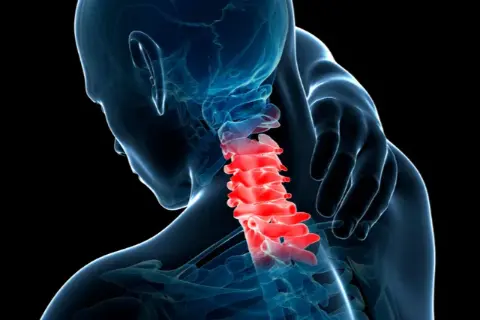What Is Cervical Instability?
Cervical instability refers to abnormal motion or lack of control between the bones (vertebrae) in the neck. It can result from ligament injury, degenerative changes, congenital abnormalities, or trauma, leading to symptoms ranging from neck pain to nerve compression and spinal cord dysfunction. Instability may be classified as either mechanical (abnormal movement on imaging) or clinical (symptoms without radiographic evidence).
This condition can progressively worsen if left untreated, particularly if it compromises spinal cord or nerve root function.
Causes and Risk Factors
- Trauma to the neck (e.g., whiplash, sports injuries)
- Rheumatoid arthritis and other inflammatory conditions
- Congenital disorders like Down syndrome or Ehlers-Danlos syndrome
- Degenerative disc disease or cervical spondylosis
- Prior cervical spine surgery (e.g., post-laminectomy instability)
- Ligament laxity due to connective tissue disorders
Symptoms
Cervical instability can produce a wide range of symptoms depending on the severity and structures involved:
- Chronic or intermittent neck pain
- Clicking, grinding, or catching sensation in the neck
- Neck stiffness and restricted movement
- Headaches, especially at the base of the skull
- Sensations of neck “giving way” or instability
- Radiating arm pain, numbness, or tingling
- Balance problems or unsteady gait (in more severe cases)
- Visual disturbances or dizziness (if upper cervical spine is involved)
Diagnosis
- Clinical evaluation of neck mobility, posture, and neurological function
- Flexion-extension X-rays: Detect abnormal vertebral movement
- MRI: Assesses spinal cord, nerve roots, and soft tissue structures
- CT scan: Detailed bone imaging to evaluate fractures or deformities
- Dynamic or upright MRI (in select cases) to reveal movement-related issues
Treatment
Non-Surgical Treatment
- Physical therapy: Focused on improving muscular support and neck control
- Activity modification to avoid aggravating movements
- Use of a soft or rigid cervical collar (short-term support)
- Anti-inflammatory medications for pain and stiffness
- Injections (e.g., cervical facet blocks) in selected cases
Surgical Treatment
- Indicated if symptoms persist despite conservative management or if spinal cord/nerve compression is present
- Spinal fusion is the most common procedure, using rods, screws, and bone grafts to stabilize affected segments
- Decompression may be performed simultaneously to relieve nerve impingement
- Surgery aims to restore spinal alignment, prevent neurological damage, and eliminate instability
Recovery Timeline
- Non-surgical patients often see gradual improvement over 6–12 weeks with consistent therapy
- Post-surgical recovery typically involves:
- Hospital stay: 1–3 days
- Neck brace: 4–6 weeks depending on procedure
- Physical therapy: Begins after initial healing phase
- Return to light activity: ~6–8 weeks
- Full recovery: 3–6 months, with ongoing strengthening and mobility work
Expert Treatment at Kerlan Jobe Institute
Cervical instability requires expert diagnosis and precision care. At Kerlan Jobe Institute, our spine specialists offer comprehensive evaluation and both non-surgical and surgical options to stabilize the cervical spine, relieve symptoms, and prevent long-term complications. We guide each patient through individualized care tailored to the severity and cause of their condition.

